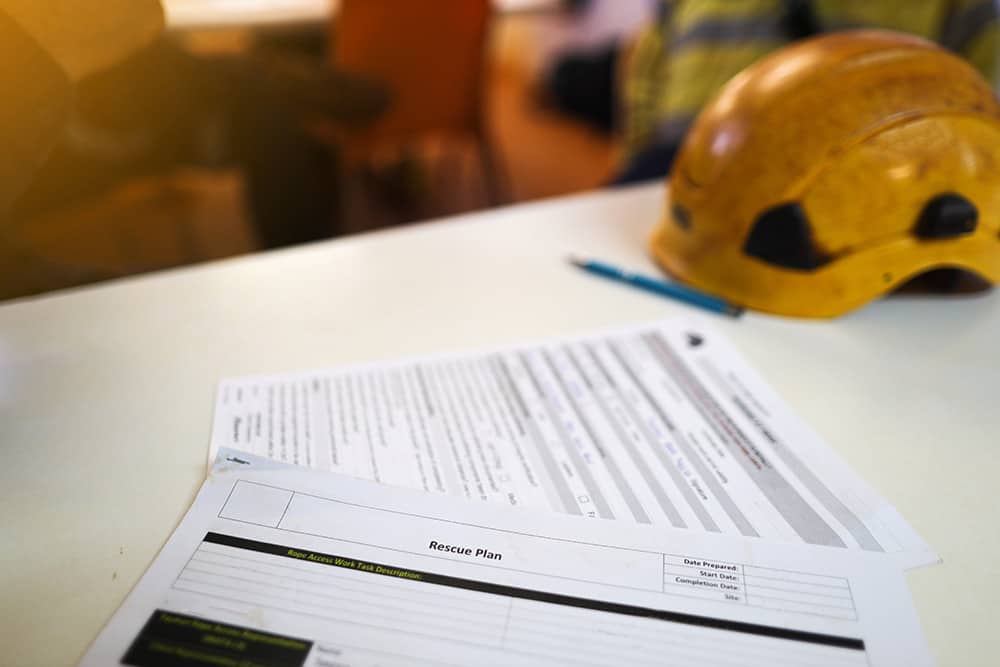
Those who conduct work at height face an increased risk of injury or death. As such, any employer whose operations involve this type of work, must ensure working at height is risk assessed and proper controls are in place.
As part of these controls, a suitable working at height rescue plan must be in place where required. This plan will ensure that should an accident occur, vital assistance can be provided before emergency personnel arrive. But knowing when you need a plan, and ensuring you have the right plan, can be confusing.
In this article, we outline the importance of a rescue plan for working at height and show you how to come up with an effective plan for your team.
The Dangers of Working at Height
From April 2021 to March 2022, nearly 30 UK workers died because of falls from height, according to a Health and Safety Executive (HSE) report. This makes falls from height the leading cause of workplace fatality across all sectors, taking up around 24% of the total. In the construction industry in England, Wales, and Scotland, it was a more prevalent cause of death, responsible for 41% of all deaths in this sector.
What is Working at Height?
Working at height is defined by the HSE as:
‘any situation where a person could fall a distance liable to cause personal injury if no precautions have been put in place’.
Working at height refers to any situation where someone is working above ground level and could fall off an edge or through an unstable surface. It also refers to situations where a person could fall from ground level into an opening such as a hole in the ground or floor.
Common examples of working at height include:
- Working on a ladder
- Working on scaffolding
- Working with trestles
- Cleaning or painting at an elevated level
- Using a step ladder
- Using a vehicle above ground level
Why You Need a Working at Height Rescue Plan
All work that must be performed at height falls under the Work at Height Regulations 2005 (WAHR). All employers and any employees that have a degree of control over working at height situations must abide by the WAHR.
The aim of the WAHR is to ensure that all practical measures are taken to avoid fatalities or injuries caused by working at height accidents. The WAHR stipulates that working at height must be ‘properly planned, appropriately supervised and carried out in a manner which is so far as is reasonably practicable safe.’ As part of this legal responsibility, employers must ensure that there is an effective, detailed and current working at height rescue plan available.

The Purpose of a Working at Height Rescue Plan
Many people are unaware that emergency services are not required to rescue anyone who has fallen from height and is suspended in a harness or where a person has become isolated at height and requires recovery. Emergency responders are obliged only to assist a person who has fallen and suffered injuries. To ensure that your workplace is safe and to comply with WAHR, it’s imperative to have a rescue plan for working at height.
Responding quickly can make all the difference if a person has fallen and is suspended at height from a harness. Fast action can mean that a person avoids serious injury and receives medical treatment quickly. The aim of a working at height rescue plan is to provide detailed instructions on how to effectively aid a suspended colleague while contacting emergency services.
What You Need to Include in a Rescue Plan for Working at Height
A working at height rescue plan should be based on information gathered by a risk assessment. A risk assessment is a legal requirement and must be done to identify all possible risks and implement control measures to eliminate or reduce these risks.
The HSE requires that a rescue plan for working at height must take the following into consideration:
- The safety of all workers involved in the rescue
- Details on anchor points for rescue equipment
- Information on the suitability of the equipment
- Instructions on how to attach an individual to the rescue equipment
- Instructions on how to move an individual using the rescue equipment
- How to address any medical, or other, needs of an individual during a rescue
The rescue plan must be able to cover situations where a worker has slipped and is unable to climb down from scaffolding, machinery or a raised platform. The plan must also address a situation where someone has fallen from ground level into an opening. It must cover situations where a worker has sustained a concussion from a falling object or suffered any other unexpected medical emergency, for example, a stroke or heart attack.
Common Equipment Used in a Working at Height Rescue Plan
- Harnesses
- Ladders
- Fall arresters
- Lifting and descending devices
- Anchor devices
- Ropes and pulleys
- Rope clamps
- Mobile Elevated Working Platforms (MEWPs)
How to Implement a Working at Height Rescue Plan
If an accident occurs and a worker is suspended at height, then the emergency authorities must be notified immediately. Before implementing a rescue plan, factors such as the weather, safety risks and the state of the equipment must be considered. An area where the worker can be safely moved to after the rescue operation must be identified.
Preparing Anchor Points
- Anchor points must be secured in the safest possible manner
- The likelihood of any obstructions or edges that could cut or damage the rescue anchor lines should be assessed
- The anchor point should not be in contact with an edge, if possible
- The anchor must be positioned so the rescue equipment can be operated safely
How to Conduct the Rescue Operation
- All people involved should be in constant communication, during the rescue operation
- The rescue operation should be done calmly with controlled and steady movements
- The condition of the worker must be constantly monitored
- If first aid is required, then a trained and competent person should administer it
- Once the rescue has been completed, a thorough review and analysis of the procedure should be made
Who Can Be Involved in a Working at Height Rescue Plan?
Everyone involved in the rescue must be competent to perform their duties. This means that they must know their role, know how to inspect, set up and operate the rescue equipment and how to effectively implement rescue procedures. To be deemed as a competent person, under health and safety legislation, workers must have received relevant training.
Where to Find Relevant Training
Our Working at Height Training course will teach your team the skills they need to work at height safely. This training gives participants the skills to identify and control the risks associated with working at height. The course can be taken online as and when work schedules allow. Trainees are awarded a certificate approved by the International Institute of Risk and Safety Management (IIRSM).
Many tragedies associated with falls from height could have been avoided had the correct safety procedures been followed and an effective working at height rescue plan been in place. As well as the protection it provides your employees, as an employer, you are required by law to ensure a working at height rescue plan is in place.
































































































































































































































































































































































































































































































































































































































































































































































